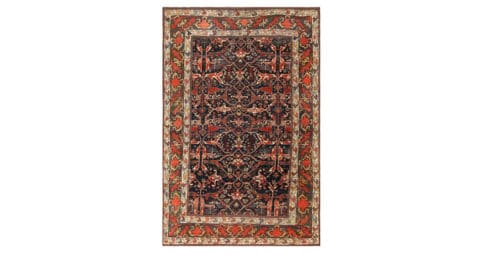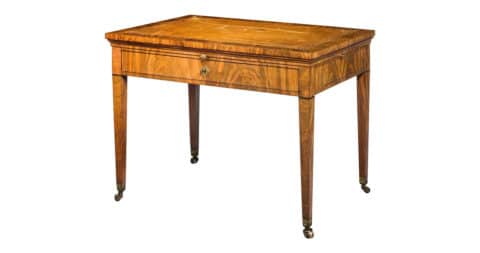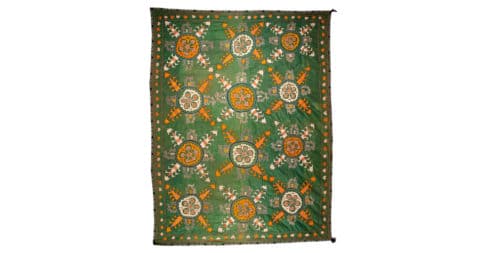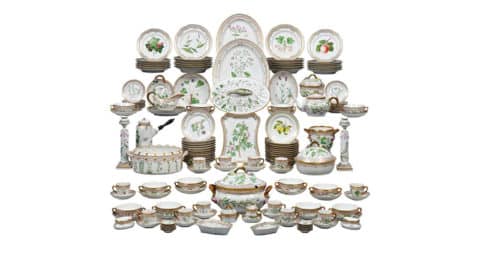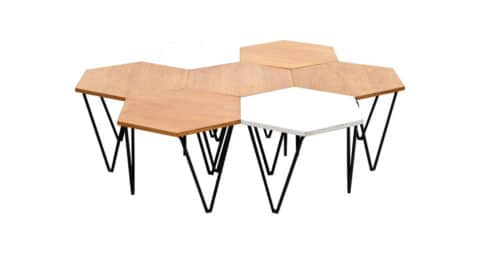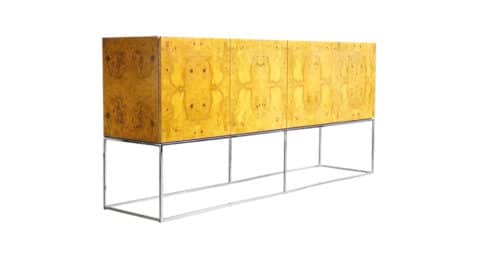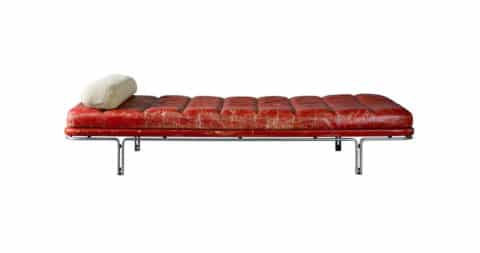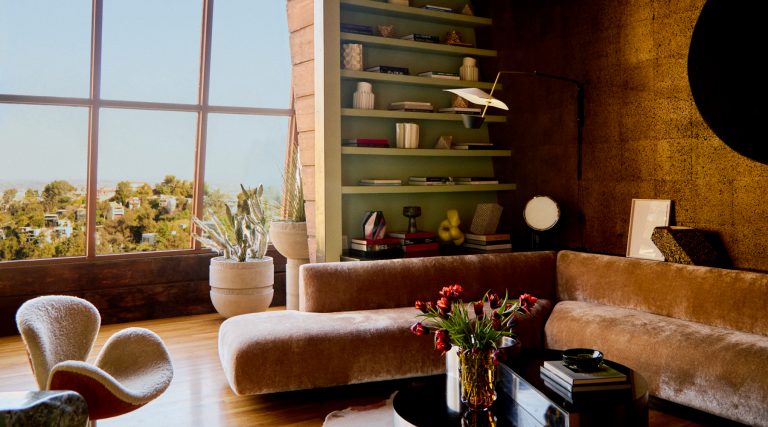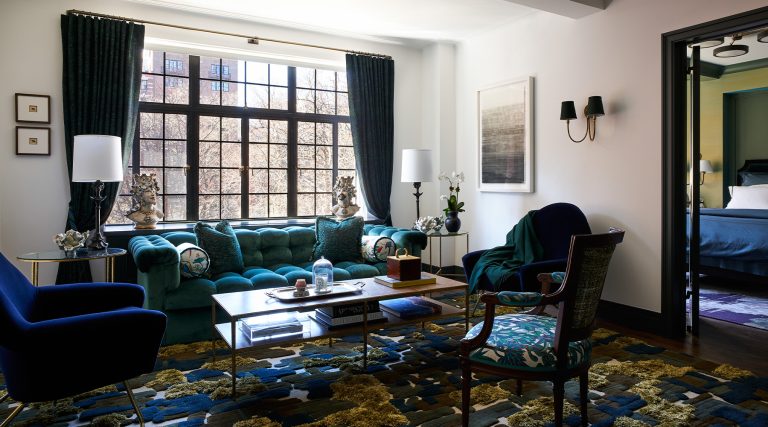
January 16, 2017Ahmad Sardar-Afkhami, with his dog, Pip, pursues projects that reflect his manifold interests (photo by Julie Holder). Top: He divided the living area of a Manhattan apartment into three spaces, including a dining area in the center. The Tuareg mat on the floor in the foreground is woven from palm fronds and leather. (photo by Attackfire Photography).
In the contemporary design world, Ahmad Sardar-Afkhami, the head of the multidisciplinary New York firm Sardar Design Studio, is something of an anomaly. While many architects and designers focus on a particular stylistic vocabulary, he is multilingual — figuratively and literally: He’s fluent in English, Persian and French and “gets by” in Spanish. His manners are courtly, but there’s nothing stuffy about him. “He has a mind that’s as refined as his taste,” says the designer Robert Couturier, a good friend. “He’s like this incredibly elegant prince who was thrown into our world.”
And where others appear concerned with crafting a brilliant career, Sardar-Afkhami is more intent on pursuing his polymath passions: architecture, landscape, interiors and decorative arts, indigenous crafts and the environment. “Having a lot of interests makes you difficult to place,” he notes, but this doesn’t seem to have held him back. His projects include renovations and restorations of Manhattan townhouses and an 18th-century riad in Morocco, apartment interiors, a Shingle-Style house in Sagaponack, on Long Island. In addition, he has worked on a villa and a soon-to-be-completed wildlife refuge and eco-resort in Jordan (both of which incorporate solar-energy elements into their clean-lined stone and concrete structures), as well as gardens and landscapes both in the United States and abroad. Sardar-Afkhami also designs crewel rugs that combine traditional techniques (they’re made by women artisans in Kashmir) with contemporary designs. “I love being able to go from grading a site to choosing fabric samples,” he says. “It’s ultimately very rewarding. It’s inhuman to pigeonhole people.” And if his project list seems cosmopolitan, that’s because he is, too.

Sardar-Afkhami and Nate Berkus sit in the Kargo headquarters, which they worked on together. The pair has also collaborated on residential projects in Manhattan and Sagaponack, New York. Photo by Julie Holder
Sardar-Afkhami was born in Iran, but in 1979 he and his family fled the revolution and settled in Paris. His parents, who were both modernist architects, turned to breeding Arabian horses when it became clear they would not be returning to their native country. At 13, Sardar-Afkhami was sent to Bryanston boarding school in England, which also counts Sir Terence Conran and his designer son Jasper as alumni. He earned his undergraduate degree at Brown University in semiotics and modern culture and media. A trip to India, where he worked on a film project that examined gender politics in traditional northern Indian architecture and design, ignited an interest in landscape architecture. So, he enrolled to study the subject at Harvard University’s Graduate School of Design, receiving a master’s in 1995. “My grandmother said, ‘Thank God you’re going to Harvard,’ but when I told her why, she said, ‘Who goes to Harvard to become a gardener?’ ”
Four years later, following a stint in the landscape architecture department of Robert A.M. Stern’s office, Sardar-Afkhami got a master’s degree in architecture from Columbia University. After working again for Stern and for the New York architect Daniel Romualdez — who, Sardar-Afkhami says, “respects the past but is never enslaved by it” — he opened his own office in 2007.
Sardar-Afkhami has collaborated with the designer Nate Berkus on a number of projects, including a West Village townhouse for culinary personality Katie Lee; the Sagaponack house of Lee’s ex-husband, Billy Joel; and offices in Manhattan for Harry Kargman’s mobile-advertising company, Kargo. Describing Sardar-Afkhami, Berkus says, “He truly understands all those elements that take a room from average to outstanding, like the Kargo offices. Sleek modernism mixed with natural reclaimed materials and handcraftsmanship — that’s classic Ahmad.”
“I love being able to go from grading a site to choosing fabric samples.”

Instead of desks, the open-plan Kargo offices have rows of long tables. Reclaimed white oak accent walls and glass-fronted conference rooms add warmth and light to the industrial-style space. Photo by Julie Holder
In Katie Lee’s townhouse, Sardar-Afkhami removed walls that had been added over the years to the 19th-century structure, restoring the rooms’ gracious proportions and creating an elegant backdrop for Berkus’s subtly luxurious mix of furnishings and fabrics. He also made contemporary changes, like opening the kitchen to the living area and creating a glamorous silver-leafed dressing room. Inspired by a California house designed by the renowned architect David Adler and his equally famous decorator sister, Frances Elkins, the room is outfitted with Serge Roche sconces and crystal door handles from E.R. Butler, as well as a jute rug, the latter a demonstration, Sardar-Afkhami says, of “Nate’s genius — his way of mixing high and low.”
For Kargo, Sardar-Afkhami turned a former industrial space above the Strand bookstore into a communal work area and private offices. He used interior windows with LEDs — which can make the glass either clear or opaque — to allow daylight into the open areas while affording privacy in the individual offices and conference room. Reclaimed wood gives the space a warmth that contrasts with the firm’s tech vibe, while custom steel windows allude to the building’s warehouse past.
It’s clear from these projects that Sardar-Afkhami can toggle with ease between historic and modern, but the space that reveals the most about his personal taste is, of course, his own apartment, in a 1929 Art Deco building in the East Village. “I think people are afraid to live the way they really want to,” he says. “A home should look lived in.” This one does, and presents a portrait of someone who loves to “travel and collect things from different time periods and cultures and own works by artist friends,” someone who also appreciates “the beauty of the techniques of ethnic crafts.”

This floral border at a horse farm in central France uses as its base colors cool pinks and grays. Photo courtesy of Ahmad Sardar-Afkhami
Sardar-Afkhami painted the apartment’s walls in Benjamin Moore’s Stonington Gray and furnished it with pieces ranging from Eames and Milo Baughman to Louis XVI-style. Central Asian suzanis share space with Parentesi lights — a classic 1971 design by Achille Castiglioni and Pio Manzu for Flos — and numerous artworks and objects. The dining room doubles as a library, reflecting Sardar-Afkhami’s preference for multipurpose rooms. This preference was inspired in part by his maternal grandmother’s flat in London, which was decorated by David Hicks and had a sofa, with piping and a bolster, that doubled as a daybed. But he cites as the ultimate precedent the 18th century, when “there was no designated use for a room — it adapted to many uses.”
Sardar-Afkhami’s home may not be as grand as those of his clients, but it reflects his love of beautiful things, something he says is in his DNA. “My grandparents had an absolute devotion to beauty and pleasure. It was the culmination of a feudal lifestyle. My paternal grandparents bred canaries and played music in their greenhouse. Certain composers, like Alban Berg, were banned, because they thought the music had adverse effects on the plants.”
Sardar-Afkhami recently finished an apartment on the 35th floor of the Ritz Tower, and he is currently at work on a townhouse in Philadelphia with a 60-foot green wall; an apartment in the Shephard, a new condominium development in an 1896 West Village building; and the renovation of a 1910 farmhouse in Washington, D.C., near Dumbarton Oaks. Asked if he has a dream project, Sardar-Afkhami makes a reply that reveals the breadth of his knowledge and passions: “An earth-friendly, passive-solar but updated house with a chicken coop,” he says. “I would also love to do an outdoor theater — a garden where you could have a pastoral concert, like the green theaters of the eighteenth century.”












